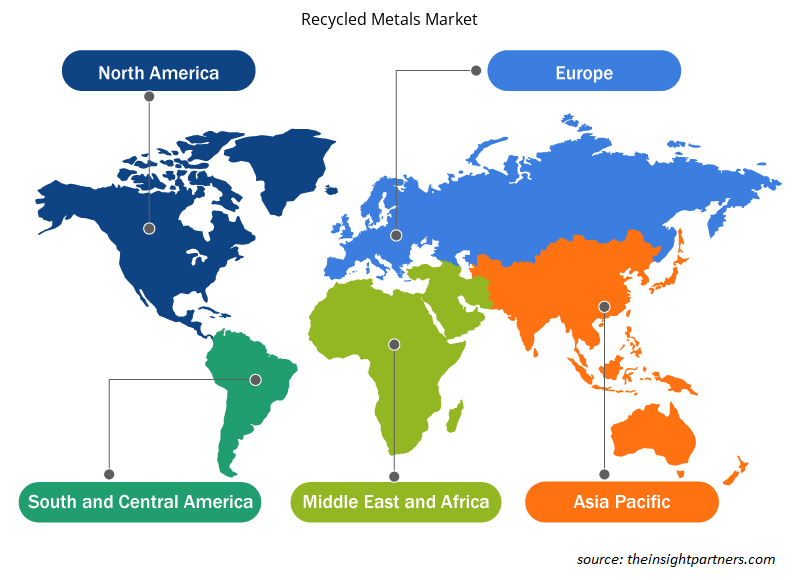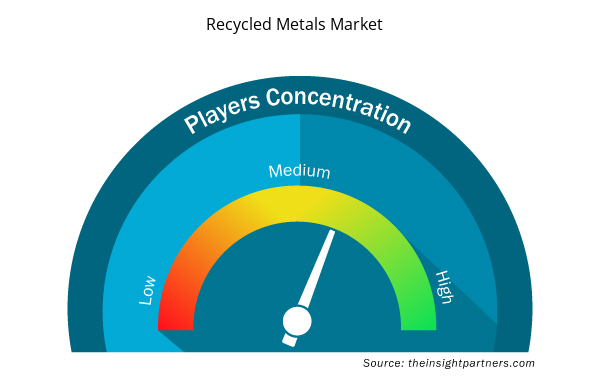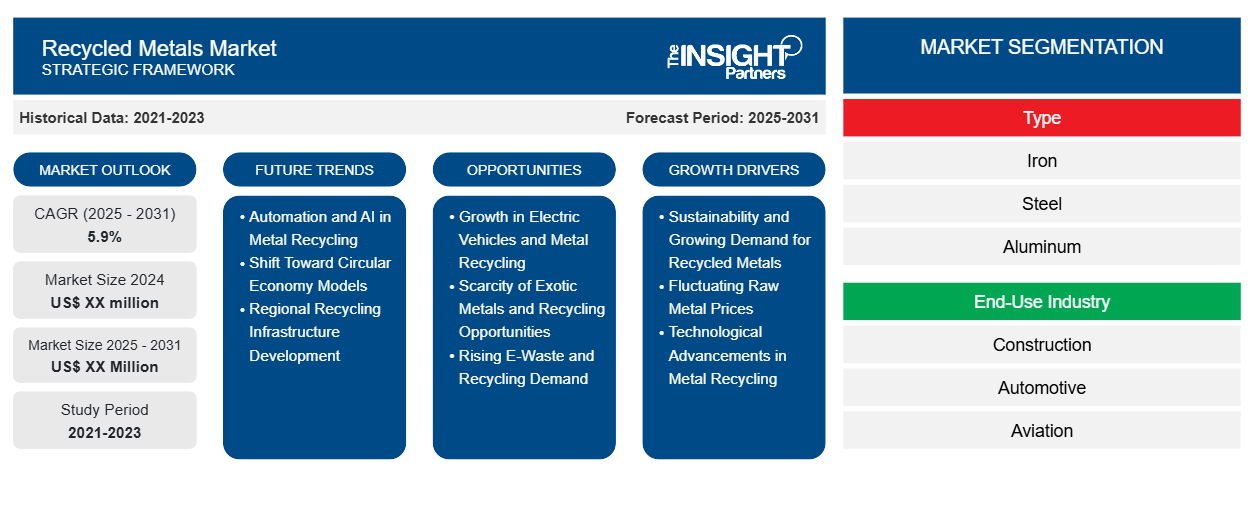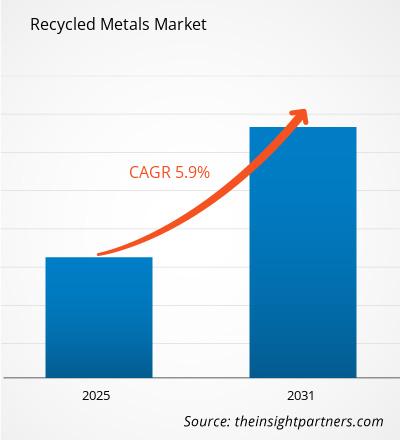Se espera que el mercado de metales reciclados registre una CAGR del 5,9 % entre 2023 y 2031, con un tamaño de mercado que se expandirá de US$ XX millones en 2023 a US$ XX millones en 2031.
El informe está segmentado por tipo (hierro, acero, aluminio, cobre, níquel, platino, plomo, estaño y otros). El informe está segmentado además por industria de uso final (construcción, automoción, aviación, bienes de consumo duraderos, maquinaria industrial, embalaje y otros). El alcance del informe cubre cinco regiones: América del Norte, Europa, Asia Pacífico, Oriente Medio y África, y América del Sur y Central y los países clave de cada región. El análisis global se desglosa aún más a nivel regional y por países principales. El informe ofrece el valor en USD para el análisis y los segmentos anteriores.
Propósito del Informe
El informe Recycled Metals Market de The Insight Partners tiene como objetivo describir el panorama actual y el crecimiento futuro, los principales factores impulsores, los desafíos y las oportunidades. Esto proporcionará información a diversas partes interesadas del negocio, como:
- Proveedores/fabricantes de tecnología: Para comprender la dinámica cambiante del mercado y conocer las oportunidades potenciales de crecimiento, lo que les permitirá tomar decisiones estratégicas informadas.
- Inversionistas: Realizar un análisis exhaustivo de tendencias sobre la tasa de crecimiento del mercado, las proyecciones financieras del mercado y las oportunidades que existen en toda la cadena de valor.
- Órganos reguladores: Regular las políticas y vigilar las actividades del mercado con el objetivo de minimizar los abusos, preservar la confianza de los inversores y defender la integridad y estabilidad del mercado.
Segmentación del mercado de metales reciclados
Tipo
- Hierro
- Acero
- Aluminio
- Cobre
- Níquel
- Platino
- Dirigir
- Estaño
Industria de uso final
- Construcción
- Automotor
- Aviación
- Bienes de consumo duraderos
- Maquinaria industrial
- Embalaje
Personalice este informe según sus necesidades
Obtendrá personalización en cualquier informe, sin cargo, incluidas partes de este informe o análisis a nivel de país, paquete de datos de Excel, así como también grandes ofertas y descuentos para empresas emergentes y universidades.
- Obtenga las principales tendencias clave del mercado de este informe.Esta muestra GRATUITA incluirá análisis de datos, desde tendencias del mercado hasta estimaciones y pronósticos.
Factores impulsores del crecimiento del mercado de metales reciclados
- Sostenibilidad y creciente demanda de metales reciclados: A medida que aumenta la conciencia ambiental, la sostenibilidad está en boca de todos en las industrias actuales. Los gobiernos, las corporaciones y los consumidores se están volviendo cada vez más ecológicos, lo que impulsa la demanda de metales reciclados. El reciclaje metalúrgico conserva los recursos naturales, ahorra energía y reduce los efectos de la degradación ambiental. Las regulaciones como los impuestos al carbono y las normas de gestión de residuos alientan a las empresas a adoptar modelos de economía circular, lo que impulsa la demanda de metales reciclados como una alternativa ecológica a los metales vírgenes.
- Fluctuaciones en los precios de los metales en bruto: las fluctuaciones globales en el precio de los metales vírgenes (aluminio, cobre y acero) suelen afectar la demanda de metales reciclados. Cuando los metales en bruto se vuelven demasiado caros para extraerlos, es mejor reciclarlos. La tendencia más reciente de este fenómeno se observa en las industrias automotriz y de la construcción, donde la demanda de metales sigue siendo alta y el reciclaje de metales ofrece una ventaja de precio con la sostenibilidad como beneficio adicional. El reciclaje brindará estabilidad a las empresas con precios de metales fluctuantes porque ofrece una cadena de suministro más barata.
- Avances tecnológicos en el reciclaje de metales: Los avances tecnológicos en la tecnología de reciclaje de metales hacen que los procesos sean más eficientes y que los productos resultantes sean de mayor calidad. Las técnicas mejoradas de clasificación permiten un mejor uso de la separación automatizada y una fundición más eficaz, lo que garantiza una mayor pureza y rendimiento de los metales que se reciclarán. Las innovaciones en esta tecnología han hecho que el reciclaje sea más rentable, lo que permite que más industrias utilicen los metales reciclados disponibles en aplicaciones de gama alta, como la electrónica y el sector automovilístico, que requieren una gran cantidad de materiales en condiciones de integridad. Las tecnologías de reciclaje más nuevas hacen que la extracción de metales preciosos sea más económica, lo que mejora el mercado en general.
Tendencias futuras del mercado de metales reciclados
- Automatización e inteligencia artificial en el reciclaje de metales: las tecnologías de automatización e inteligencia artificial se están incorporando a la industria del reciclaje de metales en un esfuerzo por optimizar la clasificación, el procesamiento y el transporte de chatarra. Los sistemas de clasificación automatizados basados en inteligencia artificial y aprendizaje automático mejoran la identificación de metales con mayor precisión, lo que mejora la calidad de los materiales reciclados y reduce los costos operativos. Las innovaciones logradas a través de estos avances están haciendo que el proceso de reciclaje sea más rápido y seguro, un atractivo que aprecian tanto los recicladores a gran escala como las pequeñas empresas.
- Cambio hacia modelos de economía circular: cada vez más industrias están adoptando un modelo de economía circular en el que no solo reciclan chatarra, sino que también diseñan productos que son más fáciles de reciclar. Esto se da en muchos sectores, como la electrónica, la automoción y el embalaje, en los que los productores están integrando metales reciclables en sus diseños. Las empresas han adoptado programas de recuperación para recoger productos usados para reciclarlos. Este cambio hacia una economía circular ha cosechado los beneficios del mercado de metales reciclados, ya que ha aumentado la oferta de chatarra para reciclar.
- Desarrollo de la infraestructura regional de reciclaje: en el mercado de metales reciclados, cada vez tienen más importancia las infraestructuras regionales de reciclaje y los países, en particular los de la Unión Europea y América del Norte, que están trabajando para crear capacidades internas de reciclaje más importantes para reducir su dependencia de la chatarra importada. La tendencia regional también va de la mano con la creciente importancia que se otorga a reducir los costos de transporte y a reducir la huella de carbono que se genera al enviar chatarra a través de las fronteras nacionales.
Oportunidades de mercado para metales reciclados
- Crecimiento de vehículos eléctricos y reciclaje de metales: el crecimiento de los vehículos eléctricos se observa a nivel mundial, lo que aumenta la demanda de aluminio, cobre y litio. Estos metales se utilizan en los vehículos eléctricos, especialmente en sus baterías y motores y en muchos componentes de la carrocería diseñados para reducir el peso de los vehículos. Su reciclaje puede servir como una oportunidad para abordar la creciente demanda de una manera respetuosa con el medio ambiente. Existe la necesidad de aumentar la disponibilidad de metales reciclados para complementar los suministros extraídos y, en consecuencia, aliviar los efectos de la extracción de dichos metales.
- Escasez de metales exóticos y oportunidades de reciclaje: el aumento del consumo de metales escasos y exóticos como el litio, el cobalto y las tierras raras en productos electrónicos y equipos de energía renovable proporcionará un nuevo mercado para el negocio del reciclaje. Actualmente no existen procesos de reciclaje disponibles para estos metales, pero a medida que la tecnología mejore, pueden resultar viables nuevas tecnologías para reciclar económicamente estos materiales a partir de productos electrónicos al final de su vida útil, baterías usadas e infraestructura de energía renovable. Esto establecería una nueva fuente de ingresos para el mercado de metales reciclados y contribuiría al cambio del mundo hacia una energía más limpia.
- Demanda creciente de desechos electrónicos y reciclaje: a medida que aumenta el volumen de desechos electrónicos a nivel mundial, existe un margen considerable para reciclar metales en los productos electrónicos de consumo desechados. Los metales presentes en los desechos electrónicos incluyen oro, plata, cobre y paladio. Las regulaciones, junto con una mayor concienciación entre los consumidores, obligarían a mejorar los métodos de reciclaje de desechos electrónicos, lo que proporcionaría la tan necesaria fuente de metales al mundo, además de ocuparse de los problemas ambientales que surgen de la generación de desechos electrónicos. A medida que los países avanzan hacia una legislación más estricta sobre el reciclaje de desechos electrónicos, más empresas especializadas en este nicho pueden captar una mayor participación de mercado.
Perspectivas regionales del mercado de metales reciclados
Los analistas de Insight Partners explicaron en detalle las tendencias y los factores regionales que influyen en el mercado de metales reciclados durante el período de pronóstico. Esta sección también analiza los segmentos y la geografía del mercado de metales reciclados en América del Norte, Europa, Asia Pacífico, Oriente Medio y África, y América del Sur y Central.

- Obtenga datos regionales específicos para el mercado de metales reciclados
Alcance del informe sobre el mercado de metales reciclados
| Atributo del informe | Detalles |
|---|---|
| Tamaño del mercado en 2023 | XX millones de dólares estadounidenses |
| Tamaño del mercado en 2031 | US$ XX millones |
| CAGR global (2023 - 2031) | 5,9% |
| Datos históricos | 2021-2022 |
| Período de pronóstico | 2024-2031 |
| Segmentos cubiertos | Por tipo
|
| Regiones y países cubiertos | América del norte
|
| Líderes del mercado y perfiles de empresas clave |
|
Densidad de actores del mercado de metales reciclados: comprensión de su impacto en la dinámica empresarial
El mercado de metales reciclados está creciendo rápidamente, impulsado por la creciente demanda de los usuarios finales debido a factores como la evolución de las preferencias de los consumidores, los avances tecnológicos y una mayor conciencia de los beneficios del producto. A medida que aumenta la demanda, las empresas amplían sus ofertas, innovan para satisfacer las necesidades de los consumidores y aprovechan las tendencias emergentes, lo que impulsa aún más el crecimiento del mercado.
La densidad de actores del mercado se refiere a la distribución de las empresas o firmas que operan dentro de un mercado o industria en particular. Indica cuántos competidores (actores del mercado) están presentes en un espacio de mercado determinado en relación con su tamaño o valor total de mercado.
Las principales empresas que operan en el mercado de metales reciclados son:
- Metales Aaron
- Reciclaje de metales Century Limited
- Reciclaje de metales europeo limitado
- Grupo Kuusakoski Oy
- Corporación Nucor
Descargo de responsabilidad : Las empresas enumeradas anteriormente no están clasificadas en ningún orden particular.

- Obtenga una descripción general de los principales actores clave del mercado de metales reciclados
Puntos de venta clave
- Cobertura integral: el informe cubre exhaustivamente el análisis de productos, servicios, tipos y usuarios finales del mercado de metales reciclados, proporcionando un panorama holístico.
- Análisis de expertos: el informe se compila sobre la base de un profundo conocimiento de expertos y analistas de la industria.
- Información actualizada: El informe asegura relevancia comercial debido a su cobertura de información reciente y tendencias de datos.
- Opciones de personalización: este informe se puede personalizar para satisfacer los requisitos específicos del cliente y adaptarse adecuadamente a las estrategias comerciales.
Por lo tanto, el informe de investigación sobre el mercado de metales reciclados puede ayudar a abrir camino para descifrar y comprender el escenario de la industria y las perspectivas de crecimiento. Si bien puede haber algunas preocupaciones válidas, los beneficios generales de este informe tienden a superar las desventajas.
- Análisis histórico (2 años), año base, pronóstico (7 años) con CAGR
- Análisis PEST y FODA
- Tamaño del mercado Valor/volumen: global, regional, nacional
- Industria y panorama competitivo
- Conjunto de datos de Excel


- Underwater Connector Market
- Hair Wig Market
- Cosmetic Bioactive Ingredients Market
- Energy Recovery Ventilator Market
- Batter and Breader Premixes Market
- Pipe Relining Market
- Aquaculture Market
- Influenza Vaccines Market
- Semiconductor Metrology and Inspection Market
- Integrated Platform Management System Market

Report Coverage
Revenue forecast, Company Analysis, Industry landscape, Growth factors, and Trends

Segment Covered
This text is related
to segments covered.

Regional Scope
North America, Europe, Asia Pacific, Middle East & Africa, South & Central America

Country Scope
This text is related
to country scope.
Preguntas frecuentes
Integration of artificial intelligence and automation is expected to be the key market trend.
The report can be delivered in PDF/Word format, we can also share excel data sheet based on request.
On the basis of geography, the recycled metals market is classified into North America, Europe, Asia Pacific, Middle East and Africa, and South and Central America
Schnitzer Steel Industries Inc, ArcelorMittal SA, European Metal Recycling Ltd, Norsk Hydro ASA, Hindalco Industries Ltd, Aurubis AG, Nucor Corp, Commercial Metals Co, Sims Ltd, and DOWA HOLDINGS CO LTD
The major factors driving the recycled metals market are:
1. Increasing Demand for Sustainable Practices.
2. Rising Scrap Metal Prices.
The Recycled Metals Market is estimated to witness a CAGR of 5.9% from 2023 to 2031
Trends and growth analysis reports related to Chemicals and Materials : READ MORE..
The List of Companies
1. Aaron Metals
2. Century Metal Recycling Limited
3. European Metal Recycling Limited
4. Kuusakoski Group Oy
5. Nucor Corporation
6. OmniSource Corp. (Steel Dynamics Inc. )
7. SA Recycling LLC
8. Schnitzer Steel Industries, Inc.
9. Sims Metal Management Ltd
10. Umicore N. V.
The Insight Partners performs research in 4 major stages: Data Collection & Secondary Research, Primary Research, Data Analysis and Data Triangulation & Final Review.
- Data Collection and Secondary Research:
As a market research and consulting firm operating from a decade, we have published and advised several client across the globe. First step for any study will start with an assessment of currently available data and insights from existing reports. Further, historical and current market information is collected from Investor Presentations, Annual Reports, SEC Filings, etc., and other information related to company’s performance and market positioning are gathered from Paid Databases (Factiva, Hoovers, and Reuters) and various other publications available in public domain.
Several associations trade associates, technical forums, institutes, societies and organization are accessed to gain technical as well as market related insights through their publications such as research papers, blogs and press releases related to the studies are referred to get cues about the market. Further, white papers, journals, magazines, and other news articles published in last 3 years are scrutinized and analyzed to understand the current market trends.
- Primary Research:
The primarily interview analysis comprise of data obtained from industry participants interview and answers to survey questions gathered by in-house primary team.
For primary research, interviews are conducted with industry experts/CEOs/Marketing Managers/VPs/Subject Matter Experts from both demand and supply side to get a 360-degree view of the market. The primary team conducts several interviews based on the complexity of the markets to understand the various market trends and dynamics which makes research more credible and precise.
A typical research interview fulfils the following functions:
- Provides first-hand information on the market size, market trends, growth trends, competitive landscape, and outlook
- Validates and strengthens in-house secondary research findings
- Develops the analysis team’s expertise and market understanding
Primary research involves email interactions and telephone interviews for each market, category, segment, and sub-segment across geographies. The participants who typically take part in such a process include, but are not limited to:
- Industry participants: VPs, business development managers, market intelligence managers and national sales managers
- Outside experts: Valuation experts, research analysts and key opinion leaders specializing in the electronics and semiconductor industry.
Below is the breakup of our primary respondents by company, designation, and region:

Once we receive the confirmation from primary research sources or primary respondents, we finalize the base year market estimation and forecast the data as per the macroeconomic and microeconomic factors assessed during data collection.
- Data Analysis:
Once data is validated through both secondary as well as primary respondents, we finalize the market estimations by hypothesis formulation and factor analysis at regional and country level.
- Macro-Economic Factor Analysis:
We analyse macroeconomic indicators such the gross domestic product (GDP), increase in the demand for goods and services across industries, technological advancement, regional economic growth, governmental policies, the influence of COVID-19, PEST analysis, and other aspects. This analysis aids in setting benchmarks for various nations/regions and approximating market splits. Additionally, the general trend of the aforementioned components aid in determining the market's development possibilities.
- Country Level Data:
Various factors that are especially aligned to the country are taken into account to determine the market size for a certain area and country, including the presence of vendors, such as headquarters and offices, the country's GDP, demand patterns, and industry growth. To comprehend the market dynamics for the nation, a number of growth variables, inhibitors, application areas, and current market trends are researched. The aforementioned elements aid in determining the country's overall market's growth potential.
- Company Profile:
The “Table of Contents” is formulated by listing and analyzing more than 25 - 30 companies operating in the market ecosystem across geographies. However, we profile only 10 companies as a standard practice in our syndicate reports. These 10 companies comprise leading, emerging, and regional players. Nonetheless, our analysis is not restricted to the 10 listed companies, we also analyze other companies present in the market to develop a holistic view and understand the prevailing trends. The “Company Profiles” section in the report covers key facts, business description, products & services, financial information, SWOT analysis, and key developments. The financial information presented is extracted from the annual reports and official documents of the publicly listed companies. Upon collecting the information for the sections of respective companies, we verify them via various primary sources and then compile the data in respective company profiles. The company level information helps us in deriving the base number as well as in forecasting the market size.
- Developing Base Number:
Aggregation of sales statistics (2020-2022) and macro-economic factor, and other secondary and primary research insights are utilized to arrive at base number and related market shares for 2022. The data gaps are identified in this step and relevant market data is analyzed, collected from paid primary interviews or databases. On finalizing the base year market size, forecasts are developed on the basis of macro-economic, industry and market growth factors and company level analysis.
- Data Triangulation and Final Review:
The market findings and base year market size calculations are validated from supply as well as demand side. Demand side validations are based on macro-economic factor analysis and benchmarks for respective regions and countries. In case of supply side validations, revenues of major companies are estimated (in case not available) based on industry benchmark, approximate number of employees, product portfolio, and primary interviews revenues are gathered. Further revenue from target product/service segment is assessed to avoid overshooting of market statistics. In case of heavy deviations between supply and demand side values, all thes steps are repeated to achieve synchronization.
We follow an iterative model, wherein we share our research findings with Subject Matter Experts (SME’s) and Key Opinion Leaders (KOLs) until consensus view of the market is not formulated – this model negates any drastic deviation in the opinions of experts. Only validated and universally acceptable research findings are quoted in our reports.
We have important check points that we use to validate our research findings – which we call – data triangulation, where we validate the information, we generate from secondary sources with primary interviews and then we re-validate with our internal data bases and Subject matter experts. This comprehensive model enables us to deliver high quality, reliable data in shortest possible time.


 Obtenga una muestra gratuita de este informe
Obtenga una muestra gratuita de este informe